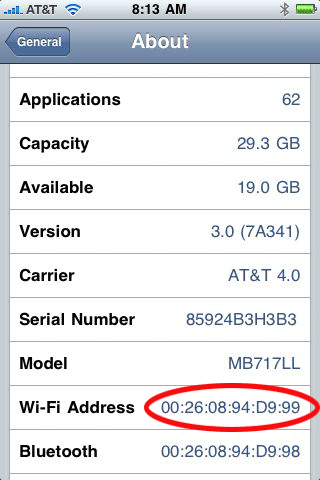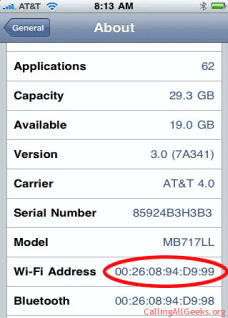

Click on the i button next to a Wi-Fi connection.Tap Wi-Fi, and make sure it’s turned on.Method 1: Find Your iPhone’s MAC Address From Wi-Fi Settingsįollow the steps below to find your iPhone’s MAC address from the Wi-Fi settings:

On the other hand, if you don’t use private Wi-Fi addresses on your iPhone/iPad, you can find its MAC address using either method. Alternatively, disable the private address feature on a Wi-Fi network and find the MAC address from its settings. In this case, you can find your original MAC address-assigned by the manufacturer-from your device’s About section. So when you connect your device to a Wi-Fi network, it sends a private Wi-Fi address to the network for identification. With iOS 15 and iPadOS 15, the private Wi-Fi address option is already enabled on your iPhone and iPad.

Private Address or Private Wi-Fi Address, for the uninitiated, is a privacy feature on iPhones (and iPads) that assigns a unique MAC address to each Wi-Fi network your device connects to in order to prevent it from tracking or profiling you on the internet.

You can either find it from the Wi-Fi settings or under the About section of your iPhone.Ĭhoosing a method between the two depends entirely on whether or not you’ve enabled private Wi-Fi addresses on your iPhone. How to Find Your iPhone’s MAC AddressĪpple offers two ways to find your iPhone’s MAC address. And, of course, it has nothing to do with the other popular Apple lineup, the MacBooks. There are some reasons not to use this feature on your iPhone, though.A MAC address isn’t to be confused with an IP address, which works on a different OSI layer and is responsible for communication outside the local network. This prevents the network from identifying your phone and helps keep maintain privacy. With that, your iPhone uses a random MAC address when it connects to a Wi-Fi network. To combat that, Apple offers a Private Address feature on iPhones. For example, if a company has multiple wireless hotspots around the city, and you connect to multiple of those hotspots, that company knows that it was you who visited multiple of their locations. Since your iPhone has a unique MAC address, wireless networks can use this address to uniquely identify you and trace your locations. RELATED: Why You Shouldn’t Use MAC Address Filtering On Your Wi-Fi Router Apple’s Privacy Options for MAC Addresses This allows you to decide what bandwidth to give your specific device based on its MAC address, and whether to allow or disallow it from connecting to your network. For example, you might use it for MAC filtering (though we don’t necessarily recommend it). You can now use this address however you want.


 0 kommentar(er)
0 kommentar(er)
